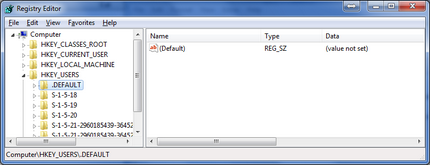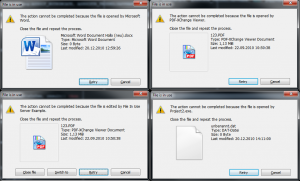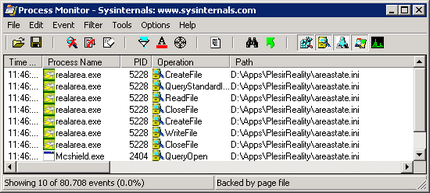Remko Weijnen's Blog (Remko's Blog)
About Virtualization, VDI, SBC, Application Compatibility and anything else I feel like
7,505 views
Today I was working on Unattended Installation of an Application called SmartDocuments.
The application seemed to behave nicely on a Multi User (Citrix/Terminal Server) environment: it writes user configuration to the user part of the registry and writes configuration files in a user accessible path.
When testing with a normal user account I ran into a problem though, I got an Oracle ORA-01019 error message:
The English message is ORA01019: unable to allocate memory in the user side.
If you are implementing a Citrix, Terminal Server or even just a plain Client-Server environment you will need to create a Default User Profile at some point.
The Default User Profile can be thought of as the initial registry settings that are used when a new profile is created.
Many people think that the Default User Profile is available in regedit via HKEY_USERS\.Default but this is NOT the Default User Profile.
Today I wanted to install the Dutch Language pack for Internet Explorer 8, the Dutch language comes as part of the Windows Internet Explorer 8 MUI Pack (in my case the version for Windows Server 2003 SP2).
If you install the MUI Pack you will always end up with all 35 (!) languages installed. This behaviour is the same as the language pack for Internet Explorer 7 that I wrote about earlier (see Modifying Microsoft Updates and/or hotfixes)
The solution is really the same as for the IE7 language pack: you modify the inf file (in my case update_srv03.inf) but if you run update.exe it will refuse to use your modified inf file:
So we need to patch update.exe to accept your modified version!
Have you developed an application that accesses files and may stop because a file cannot be accessed but you need to?
Since Windows Vista it is possible to find out the name of the application which holds open a file.
And we have created a solution for you that doesn’t require a driver, nor does it need Administrator rights! Just plain user source code for you to use instantly.
We have developed a solution in Delphi that can show your user which application stalls your application. Look at these screenshots:
In fact, these dialogs are only for demonstration purposes. But you can get them in addition as a Delphi project!
The code itself is fairly easy to use. We have developed an extension to the official IFileIsInUse Interface from Microsoft.
1 2 3 4 5 6 7 8 9 10 11 12 13 14 | type IFileIsInUse = interface(IUnknown) ['{64a1cbf0-3a1a-4461-9158-376969693950}'] function GetAppName(out ppszName: LPWSTR) : HRESULT; stdcall; function GetUsage(out pfut : FILE_USAGE_TYPE) : HRESULT; stdcall; function GetCapabilities(out pdwCapFlags : DWORD) : HRESULT; stdcall; function GetSwitchToHWND(out phwnd : HWND) : HRESULT; stdcall; function CloseFile() : HRESULT; stdcall; end; IFileIsInUse2 = interface(IFileIsInUse) ['{C69C0E72-DCE2-474D-AC16-E31B77B526B3}'] function GetProcessID(out pdwProcessID : DWORD) : HRESULT; stdcall; end; |
All you have to do it to call this function provides by us:
1 | function GetFileInUseInfo(const FileName : WideString) : IFileIsInUse2; |
The name of the app is returned by the method GetAppName. And if the other application supports IFileIsInUse (call method GetCapabilities) interface you even can close the file or switch to the window.
You’ll see how it works in the demonstration project (images above) accompanied by the function GetFileInUseInfo.
Currently, we only offer a Delphi solution. C++ may available in future or when there’s enough demand for it.
Please use the Contact Form to get more information about how to obtain the solution and conditions.
I noticed that the monthly archives on my blog were not working. I first thought it was a problem with the .htaccess file but it was correct.
I also tried resetting the permalinks option in WordPress to default an back but that did help as well.
After some digging I was able to fix it by selecting an option in the Robots Meta plugin I use:
I selected the Disable the date-based archives option, saved settings and de-selected it again. I am not sure what it changes (the .htaccess file was not changed) nor did I check the code to see what it does but at least it’s working again!
Today I needed to create a silent install for IBM WebSphere MQ, in my case version 6.0.2.10.
I started by reading IBM’s documentation: WebSphere MQ Unattendend (silent) Installation which desribes that we can create a response file using the SAVEINI parameter.
So I recorded a response file and tested the install using the USEINI parameter as indicated by the documentation.
However the installation failed producing only this error message:
Earlier today I wrote about Using the CorrectFilePaths shim to redirect an ini file to a writable location and believe it or not the next application I was working with today needed a nice shim as well.
This one was a little more complicated and that’s why I am writing a second post about it.
I am not sure if this is actuall documented somewhere but a Shim is not applied to Applications or DLL’s that reside in the system directory.
The application in question here is a Visual Basic 6 application which uses the VB6 runtime, msvbvm60.dll which resides usually in %systemroot%\system32.
We need to do two things if we want to apply the shim to msvbvm60.dll:
Using the CorrectFilePaths shim to redirect an ini file to a writable location
Author: Remko Weijnen28 Dec
Today I needed to package an application called PlesirReality and I noticed that it wrote an ini file into the program directory (in my case D:\Apps\PlesirReality).
I looked into this ini file (areastate.ini) and it writes user settings in there, like the last position of the window etc.
We can see this easily with Process Monitor:
This presents us with several problems:
The first problem is that the user does not have write permission in this directory so upon application exit we get an ugly error message:

We could “fix” this by giving the user write permissions to this directory or even to this specific file but here comes the seconds problem:
On a multi user environment like Citrix or Terminal Server/Remote Desktop Services it means that when one user exists he will he save his settings for all users.
And then we have a third problem:
When a users starts the application on another server he will not get the expected settings because each server will have it’s own copy of this ini file.
Last week I needed to an unattended installation of the Oracle Client, in my case version 10.2.0.1.0.
Oracle has a record switch that allows you to record an installation and generate a response file using: setup -record -destinationFile response_file_name. This is documented here.
When you are finished you can use this response file to perform the unattended install, eg setup -silent -responseFile response_file_name.
There is a problem though, the installer (setup.exe) launches a java based installer and immediately returns.
This was a problem for me since I cannot deploy a dependant application if the Oracle install hasn’t finished yet.
I did some googling and found a lot of questions about this subject and saw a common resolution where a script is watching a certain file that is creating when the installation has finished in a loop.
I figured there should be a better wait so I to a closer look at the installer with Ida Pro. I noticed that setup.exe launches another exe. called oui.exe (Oracle Universal Installer) which in turn launches Java.
Today I shadowed a user’s session in Citrix and when I wanted to type something I noticed that the keyboard layout was incorrect.
This is and old “friend” that I always tend to forget about. So hopefully this post will help me to remember it :D.
You can prevent this by adding a value “IgnoreRemoteKeyboardLayout” to the registry key HKLM\System\CurrentControlSet\Keyboard Layout:
reg add “HKLM\SYSTEM\CurrentControlSet\Control\Keyboard Layout” /v IgnoreRemoteKeyboardLayout /t REG_DWORD /d 0x00000001 /f
This option has been present since Windows 2000 but was broken in Windows 2003. For Windows 2003 there are two related hotfixes, see kb 842136 and kb 917910.
Profile
Top Posts
- Query Active Directory from Excel
- RNS 510 Startup Logo–My thoughts
- Adding a hidden Exchange mailbox to Outlook
- How rdp passwords are encrypted
- Get Actual CPU Clock Speed with PowerShell
- ClickOnce Applications in Enterprise Environments
- VW RNS 510 Navigation Startup Pictures
- Unattended Installation of IBM System i Access for Windows
- Reading physical memory size from the registry
- Show Client IP Address when using NetScaler as a Reverse Proxy
Recent Comments
Featured Downloads
- AClientFix (13595 downloads )
- AddPrinter2.zip (12854 downloads )
- AdProps (12379 downloads )
- AdSample1 (11432 downloads )
- AMD Radeon Crimson ReLive (28453 downloads )
- Atheros Driver (34019 downloads )
- AutoLogonXP 1.0 (11404 downloads )
- CDZA (9560 downloads )
- ChDrvLetter.zip (11217 downloads )
- ChDrvLetter.zip (14356 downloads )
Blogroll
- Andrew Morgan
- Arnout’s blog
- Assa’s Blog
- Barry Schiffer
- Delphi Praxis
- Ingmar Verheij
- Jedi Api Blog
- Jedi API Library
- Jeroen Tielen
- Kees Baggerman
Categories
- .NET (4)
- Active Directory (28)
- Altiris (36)
- App-V (1)
- Apple (5)
- Application Compatibility (11)
- Automotive (5)
- AWS (1)
- BootCamp (1)
- C# (6)
- C++ (2)
- Citrix (87)
- Delphi (61)
- Embedded (4)
- Exchange (16)
- General (71)
- iPhone (5)
- Java (8)
- Linux (1)
- Lync (2)
- NetScaler (1)
- Oracle (4)
- Other (1)
- Packaging (19)
- PowerShell (56)
- Programming (79)
- Quest (1)
- RES (7)
- script (22)
- ShareFile (1)
- SQL Server (10)
- Strange Error (3)
- Terminal Server (68)
- ThinApp (3)
- ThinKiosk (1)
- Ubuntu (1)
- Unattended Installation (19)
- Uncategorized (51)
- UWP (2)
- Vista (37)
- Visual Studio (1)
- VMWare (26)
- Windows 10 (2)
- Windows 2003 (30)
- Windows 2008 (37)
- Windows 2008 R2 (16)
- Windows 2012 (2)
- Windows 7 (30)
- Windows 8 (4)
- Windows Internals (12)
- Windows XP (16)
Archives
- February 2023 (1)
- October 2022 (3)
- July 2022 (1)
- June 2022 (2)
- October 2019 (1)
- March 2018 (1)
- January 2018 (4)
- December 2017 (3)
- April 2017 (1)
- March 2017 (5)
- February 2017 (4)
- May 2016 (3)
- March 2016 (1)
- October 2015 (2)
- September 2015 (1)
- January 2015 (1)
- August 2014 (1)
- July 2014 (8)
- May 2014 (1)
- November 2013 (1)
- October 2013 (2)
- September 2013 (3)
- August 2013 (4)
- June 2013 (2)
- May 2013 (3)
- April 2013 (5)
- March 2013 (5)
- February 2013 (1)
- January 2013 (5)
- December 2012 (9)
- November 2012 (3)
- October 2012 (3)
- August 2012 (4)
- July 2012 (2)
- June 2012 (1)
- May 2012 (6)
- March 2012 (13)
- February 2012 (12)
- January 2012 (9)
- December 2011 (9)
- November 2011 (4)
- October 2011 (5)
- September 2011 (10)
- August 2011 (10)
- July 2011 (2)
- June 2011 (8)
- May 2011 (12)
- April 2011 (4)
- March 2011 (14)
- February 2011 (8)
- January 2011 (32)
- December 2010 (23)
- November 2010 (19)
- October 2010 (10)
- September 2010 (6)
- August 2010 (1)
- July 2010 (1)
- June 2010 (6)
- March 2010 (7)
- February 2010 (3)
- December 2009 (3)
- November 2009 (11)
- September 2009 (2)
- July 2009 (1)
- June 2009 (5)
- May 2009 (1)
- April 2009 (2)
- March 2009 (3)
- February 2009 (6)
- January 2009 (3)
- December 2008 (8)
- November 2008 (5)
- October 2008 (3)
- September 2008 (3)
- August 2008 (3)
- June 2008 (6)
- May 2008 (2)
- April 2008 (3)
- March 2008 (5)
- January 2008 (3)
- December 2007 (3)
- November 2007 (13)
- October 2007 (10)







